________________
August, 1930 ]
THE ORIGIN OF THE PALLAVAS
155
THE ORIGIN OF THE PALLAVAS.
By MUDALIYAR C. RASANAYAGAM. In volume LII (pp. 77-80) of the Indian Antiquary, an article entitled “The Origin of the Pallavas " was published over my name, and in it a theory was put forward that the progenitor of the Pallava dynasty was Tondaimán Ilam Tirayan, the son of a Chola king born of a liaison with a Någa princess of Manipallavam, and that the name "Pallava" given to the dynasty was a matronymic indicating the origin of his mother. Professor S. Krishnaswami Aiyangar, in his Lectures on South Indian History, published a short time afterwards, and in his valuable paper on “ The Origin and the Early History of the Pallavas of Kanchi," which appeared in the Journal of Indian History (vol. II, pt. 1) for Nov. 1922, held that they were native to South India and not a dynasty of foreigners. Further, on the grounds that their earliest charters were in Prakrit and Sanskrit and not in Tamil, and that their culture was Aryan and Brâhmanio and not Dravidian, he suggested that they were in all probability a family of Naga feudatorics of the Satavahanas of the Dekkhan. Sir Richard Temple, while referring to the two theories in his paper entitled " A Sketch of South Indian Culture” published in the Indian Antiquary (vol. LIII, p. 26), stated that “if the Professor's conclusions are to be accepted, Mr. Rasanayagam's argument is ruled out. However, in its favour it may be said that the acceptance of purely Indian soil as the original home of the Pallavas does not account for their name, the Sprout, which is what Mr. Rasanayagam aims at explaining. The question then is not even yet finally settled, though the foreign Pahlava origin of the Pallavas may now be definitely regarded as inadmissible."
In Vincent Smith's Early History of India (4th edition, revised by the late Mr. S. M. Edwardes, C.S.I., C.V.O., and published in 1924), Mr. Edwardes, in commenting on my theory (p. 49), stated that the possible origin of the Pallavas, as suggested by ancient Tamil poetry, did not appear to conflict with known facts and might perhaps offer an additional reason for the enmity which unquestionably existed between the Pallavas and the Tamil kingdoms. Being, however, reluctant to set aside the theory of so great a scholar and historian as Professor S. K. Aiyangar, he added that the historical Pallavas were feudatories of the Satavahanas of the Deccan and belonged to the Någa family.
Mr. R. Gopalan, the latest writer on the Pallavas in his History of the Pallavas of Kanci, edited with an Introduction by Dr. S. K. Aiyangar, and published in 1928, while reviewing all the theories propounded on the origin of the Pallavas, seems to favour the view of the learned Professor that the Pallavas must have come down from the north. The difficulties that make it impossible for him to accept my view are said to be these :
(1) that the inscriptions do not mention the Chola-Naga origin or even the name of Tondaimán Iļam Tirayan as the earliest member of the dynasty; but that on the other hand the Pallava kings described themselves as belonging to the Bharadvaja gotra, and as performers of Aryan sacrifices;
(2) that their earliest charters are in Pråkrit and Sanskrit and never in the Tamil language ; and
(3) that the early Pallava kings were hostile to the Tamil rulers such as the Cholas and the Pandyas.
These objections seem to have been put forward only for the sake of argument, for Mr. Gopalan in another part of the book (p. 160) unwillingly expresses his belief that Iļam Tirayan did belong to the Pallava dynasty, by stating that “Tirumaļisai was a contemporary of one of the Pallava kings, perhaps Tondaimán Iļam Tirayan." Further, these objeotions presuppose that the early Pallava rulers were necessarily either Tamils or patrons of the Tamil language ; but the mere fact that the progenitor of the dynasty, Tondaiman Lam Tirayan, was a patron of the Tamil language is not enough to sustain any such assumption.
If the Pallava inscriptions had mentioned the actual origin of the dynasty, there would have been no need now to search for its beginnings and its progenitors. The early Prakrit




